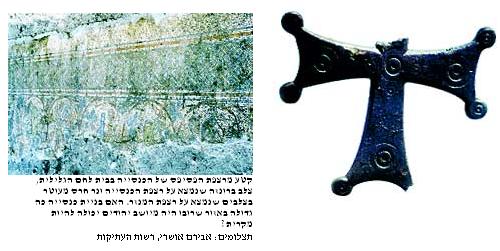Excavations in Bethlehem of Galilee strengthen the belief that Jesus was born there, near his parents' home in Nazareth, and not in Bethlehem near Jerusalem
Ran Shapira, Haaretz

Centuries of belief that Jesus was born in Bethlehem, near Jerusalem, did not convince many researchers. Joseph Klausner, for example, wrote in his book "The Christian Jesus" that the Gospels of Matthew and Luke, according to which Jesus was born in Bethlehem in Judea when his mother went down there from Nazareth for a census, sought to emphasize Jesus' belonging to the House of David, which originates from Bethlehem, to show that he Messiah. David Flosser added: "The story of the legend about the birth of Jesus came to explain in a physical way the Christian belief that Jesus is the Son of God."
Aviram Oshri, an archaeologist from the Antiquities Authority, believes that a series of salvage excavations he conducted in Bethlehem of Galilee provides archaeological evidence for these claims. Between 1992 and 2003 Osheri carried out five excavations at various sites in Bethlehem of Galilee. The excavations revealed that the place was continuously inhabited from before the Persian occupation of the Land of Israel - in the sixth century BC - until the present day.
In the period relevant to the birth of Jesus, the reign of King Herod (the end of the first century BC and the beginning of the first century AD), Jews lived in Bethlehem of Galilee. This is evidenced by the remains of cooking and storage utensils made of stone found in several excavation areas in the settlement. There is also a workshop for the production of these tools. Stone vessels characterize Jews because according to Halacha they do not receive impurity. A mausoleum carved in the shape of a synagogue was also uncovered in the ancient cemetery of Bethlehem the Galilean.
in excavations
made in Bethlehem near Jerusalem since the XNUMXs, during the British Mandate, no signs of a Jewish settlement were found during the Herodian period. In the compound of the Church of the Nativity in the city, buildings from the Byzantine period and the Middle Ages were uncovered, but no pottery or remains of buildings from the time when, according to tradition, Jesus was born were found. In the excavations carried out in the Church of the Nativity in Bethlehem, it became clear that a church was built there during the time of Emperor Constantine, in the first half of the fourth century AD. In a later layer, mosaic floors of a church from the time of Emperor Justinianus, in the sixth century AD, were found.
Oshri's excavations in Bethlehem of Galilee testify to the continued Christian presence there at least until the seventh century AD. In two different excavations, he uncovered two large buildings from the Byzantine period in the settlement. One of them was apparently used as a monastery and the other as a church. In the church yard, many oil candles were found with the sign of the cross on them, as well as a large number of pig bones. The dimensions of the church - 45 meters long and 25 meters wide - place it among the largest churches of the period. Oshri asks if it is possible that the building of such a large church in Bethlehem of Galilee, in an area that was mostly inhabited by Jews, is accidental.
In two different excavations Osheri found two sections of a wall, which seem to have been part of a wall erected to protect the Christian settlement. According to him, settlements the size of Bethlehem were not usually surrounded by a wall, but it is possible that the Christian residents there felt threatened because there were many Jewish settlements around them - Tzipori, Tivon, Osha, Beit Shaarim and more.
Another building that Osheri uncovered in Bethlehem of Galilee in 1997 was probably used as a hostel. The hostel, which was probably built around the sixth century, was a two-story structure - the upper one was used for hospitality and accommodation and its floor was paved with mosaic. On the lower floor of the building, a wall was discovered with slits at a height of about a meter above the floor. Usheri speculates that wooden slats inserted into them formed a manger, which may have been used to feed the horses that were housed on the lower floor.
The Christian public buildings uncovered in Bethlehem of Galilee existed until the beginning of the seventh century and then were destroyed, probably with the Persian conquest of 614. However, there were apparently Christians who continued to attach special importance to Bethlehem in the lower Galilee. Oshri believes, although he does not have any documents to prove it, that the settlement of the Templars there, at the beginning of the twentieth century, was related to the belief that this is the birthplace of Jesus.
Usheri expressed his ideas at the recent conference of the Antiquities Authority in Haifa, where the findings of excavations conducted in the Galilee were presented. In response, some researchers said that it is impossible that after the centralized rule of Constantine, during which the Church of the Nativity in Bethlehem was built, the tradition survived that Jesus was not born in Bethlehem in Judea. Oshri believes that the findings of the excavations point to another possibility.

One response
I don't understand how religion develops, it's hard for me to understand the material, I'm asking you to help me please